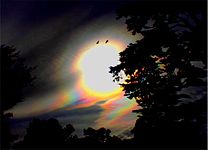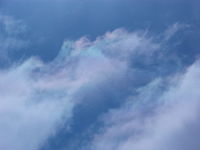- Cloud iridescence
-
Cloud iridescence is the occurrence of colors in a cloud similar to those seen in oil films on puddles, and is similar to irisation. It is a fairly uncommon phenomenon, most often observed in altocumulus, cirrocumulus and lenticular clouds, and very rarely in Cirrus clouds.[1][2][3] The colors are usually pastel, but can be very vivid. Iridescence is generally produced near the sun, with the sun's glare masking it, so it is more easily seen by hiding the sun behind a tree or building. Other aids are dark glasses, or observing the sky reflected in a convex mirror or in a pool of water.
Iridescent clouds are a diffraction phenomenon cause by small water droplets or small ice crystals individually scattering light. Larger ice crystals produce halos, which are a refraction phenomena rather than iridescence. Iridescence should similarly be distinguished from the refraction in larger raindrops that makes a rainbow.
If parts of clouds have small droplets or crystals of similar size, their cumulative effect is seen as colors. The cloud must be optically thin, so that most rays encounter only a single droplet. Iridescence is therefore mostly seen at cloud edges or in semi-transparent clouds, and newly forming clouds produce the brightest and most colorful iridescence. When a thin cloud has droplets of similar size over a large extent, the iridescence takes on the structured form of a corona, a central bright disk around the sun or moon surrounded by one or more colored rings.
See also
References
External links
- Iridescent cloud galley - Atmospheric Optics site
- On the Cause of Iridescence in Clouds - Scientific American Supplement
Categories:- Cloud types
- Atmospheric optical phenomena
- Atmospheric science stubs
Wikimedia Foundation. 2010.




